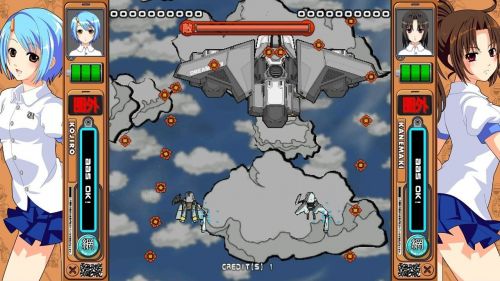
Thankfully Massive does boast a fair complement of game modes, three of which support 2-player local co-op. Arcade and its remix Expand (unlocked by code) play similarly, though I found Expand a bit less challenging and thus more enjoyable. To see the true ending of either mode, you’ll need to reach the final boss without continuing – not easy, though certainly not as impossible as your average CAVE game. Classic plays like Arcade and Expand, except it has fewer stages and features a single ranged weapon type instead of the other modes’ three.
Two short score-attack modes round out the list and don’t support multiplayer. ‘Massive’ is the traditional Caravan mode with its own unique stage. Death mode requires players to defend a building at the bottom of the screen by preventing enemies from leaving the screen. Once enough enemies escape, the building gets destroyed and the game ends. Both modes have their own score-based Achievements with requirements too lofty for my blood.
Radirgy Noa Massive is not a bad game as shoot-em-ups go. The sword and ABS mechanics certainly give it a different feel than many of its shooter brethren, and the difficulty overall is fairly reasonable (though not as easy as Bullet Soul). But the low production values really belong to another era. Shmup-haters always say this, but the game really should have been an Xbox Live Arcade release rather than a retail one. Thankfully, the Games on Demand price is fairly reasonable (~$33). If you’ve got the system to play Massive and like Achievements, it’s worth a buy. I topped out at 620 GamerScore from it, more than any CAVE game I own.
Massive Mode (above) is actually much less massive than the main game.
Cultural quirks: The anime-style art on display has a real otaku quality. Loading screens feature bizarre, nonsensical imagery, adding to the humorous atmosphere. Along those lines, one boss appears to be a train conductor or employee of some sort, and the boss of another level is an armored train. They love their trains in Japan; I wish we had more in Texas.
Chances of coming to the US: None. The shoot-em-up market is fairly niche anyway, but the chances of a low-rent game that reportedly didn’t even sell 10,000 units in Japan coming to America or Europe are non-existent.
Language barrier: Low. The menus and options are almost entirely in English, making for easy navigation. Ditto for the Achievements. The actual tutorial and story use Japanese text, but you don’t need them to get a grasp on things.
Difficulty of importing: High. As mentioned earlier, Radirgy Noa Massive is region-locked to Japanese and Asian consoles, so only people living in those countries or big importers like me will be able to play it. Production of the actual retail release has long ceased, but the Hong Kong Games on Demand version only costs 2000 MS Points – about $33. You can download it from anywhere; it's the system hardware that matters.